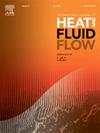Quantitative comparison of vortex identification methods in three-dimensional fluid flow around bluff bodies
IF 2.6
3区 工程技术
Q2 ENGINEERING, MECHANICAL
International Journal of Heat and Fluid Flow
Pub Date : 2025-02-16
DOI:10.1016/j.ijheatfluidflow.2025.109773
引用次数: 0
Abstract
The identification of vortices remains a critical yet unresolved challenge in fluid mechanics, as no universally accepted definition of a vortex exists. This study compares several vortex detection methods applied to the simulation of three-dimensional fluid flows around a cylinder and a rectangular cuboid at various Reynolds numbers and angles of attack, including a highly turbulent flow case. The methods under investigation include traditional Eulerian local criteria – -criterion, -criterion, and -criterion – as well as more recent approaches such as the -method, Rortex method, Omega-Liutex method, and the Lagrangian-averaged vorticity deviation (LAVD). Classification metrics and visualization methods are used to quantify and compare the performance of each method. While traditional criteria and the Rortex method demonstrated accuracy only with carefully chosen parameters, the -, and Omega-Liutex methods achieved reliable results with consistent uncertainty using threshold values near the suggested value of 0.52. In highly three-dimensional turbulent flows, all methods encountered challenges with shear contamination, though the LAVD method was the most robust. However, the LAVD method’s reliance on two-dimensional plane-based analysis limits its ability to capture the full volumetric nature of vortices in such flows, which contributed to reduced accuracy. The LAVD method is threshold independent, and can provide accurate results, however, only on the cost of high computational time. It is concluded that for applications with limited computational resources, simpler methods like the -method may be preferable. However, in scenarios requiring high accuracy, the LAVD method, despite its longer processing time, could be more effective.

求助全文
约1分钟内获得全文
求助全文
来源期刊

International Journal of Heat and Fluid Flow
工程技术-工程:机械
CiteScore
5.00
自引率
7.70%
发文量
131
审稿时长
33 days
期刊介绍:
The International Journal of Heat and Fluid Flow welcomes high-quality original contributions on experimental, computational, and physical aspects of convective heat transfer and fluid dynamics relevant to engineering or the environment, including multiphase and microscale flows.
Papers reporting the application of these disciplines to design and development, with emphasis on new technological fields, are also welcomed. Some of these new fields include microscale electronic and mechanical systems; medical and biological systems; and thermal and flow control in both the internal and external environment.
 求助内容:
求助内容: 应助结果提醒方式:
应助结果提醒方式:


